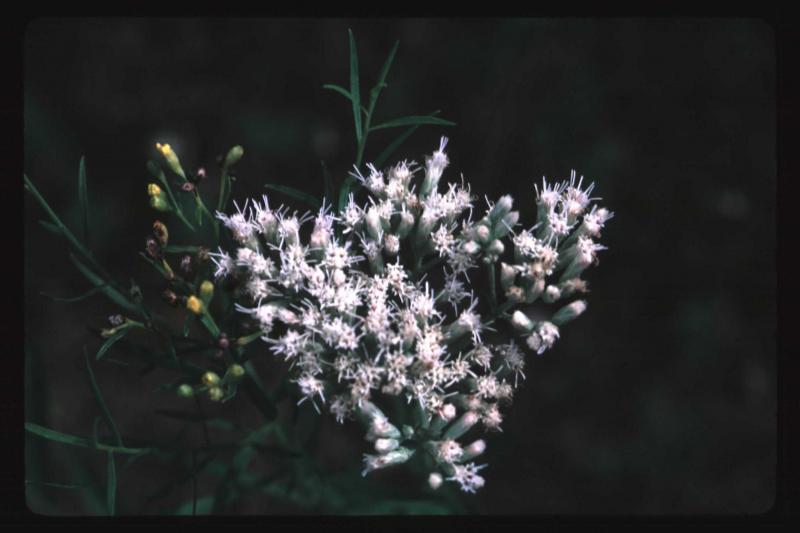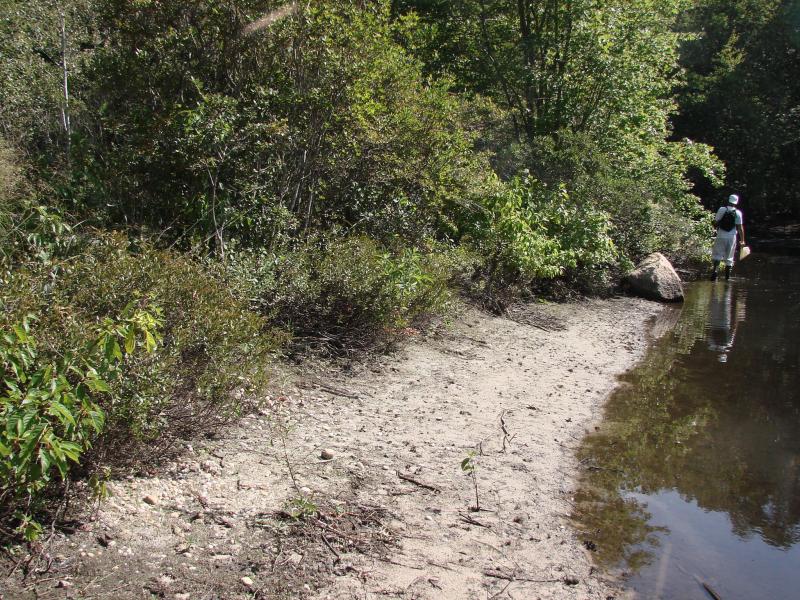White-bracted Boneset
Eupatorium leucolepis var. leucolepis None
- Class
- Dicotyledoneae (Dicots)
- Family
- Asteraceae (Aster Family)
- State Protection
- Endangered
Listed as Endangered by New York State: in imminent danger of extirpation in New York. For animals, taking, importation, transportation, or possession is prohibited, except under license or permit. For plants, removal or damage without the consent of the landowner is prohibited.
- Federal Protection
- Not Listed
- State Conservation Status Rank
- S1
Critically Imperiled in New York - Especially vulnerable to disappearing from New York due to extreme rarity or other factors; typically 5 or fewer populations or locations in New York, very few individuals, very restricted range, very few remaining acres (or miles of stream), and/or very steep declines.
- Global Conservation Status Rank
- G5T5
Secure globally - Both the species as a whole and the subspecies/variety are common in the world; widespread and abundant (but may be rare in some parts of its range).
Summary
Did you know?
The common name Justiceweed comes from the success for curing the bites of snakes and other poisonous animals by a John Justice of South Carolina in 1800, who people paid for the use of his recipe (Kress 2009). The species name leucolepis means white-scaled and refers to the white-haired bracts beneath the flower heads (Fernald 1950).
State Ranking Justification
This plant has always been rare in New York. There are two existing populations, containing a few plants each. There are three known historical occurrences.
Short-term Trends
No recent surveys have been done to evaluate short-term trends.
Long-term Trends
This plant only ever had a few occurrences in New York and future trends will probably not change.
Conservation and Management
Threats
One population along a roadside is threatened by improper mowing regimes.
Conservation Strategies and Management Practices
This species needs disturbance to reduce competition from woody plants or more aggressive herbaceous plants but too much direct disturbance to the plants will reduce or eliminate the population. Its habitat could be disturbed in the non-growing season to reduce competition to allow for seed germination and colonization but direct disturbance should be prevented during the growing season.
Research Needs
Research is needed to see if populations can be augmented where they exist.
Habitat
Habitat
The few known locations for this species in New York State have been weedy or shrubby margins of shallow pond shores, and in one case along an abandoned roadway (New York Natural Heritage Program 2010). Damp sands and peats of the coastal plain (Fernald 1970). Pine barrens, wet meadows, and margins of ponds, especially in sandy soil (Gleason & Cronquist 1991). Pine barrens, wet meadows, margins of ponds, sandy soils (FNA 2006).
Associated Ecological Communities
- Coastal plain pond shore
(guide)
The gently sloping shore of a coastal plain pond with seasonally and annually fluctuating water levels. Plants growing on the pond shore vary with water levels. In dry years when water levels are low there is often a dense growth of annual sedges, grasses, and herbs. Submerged and floating-leaved aquatic plants, such as fragrant waterlily and pondweeds, may become "stranded" on the exposed shore. In wet years when the water level is high only a few emergents and floating-leaved aquatics may be noticeable. T
- Mowed roadside/pathway
A narrow strip of mowed vegetation along the side of a road, or a mowed pathway through taller vegetation (e.g., meadows, old fields, woodlands, forests), or along utility right-of-way corridors (e.g., power lines, telephone lines, gas pipelines). The vegetation in these mowed strips and paths may be dominated by grasses, sedges, and rushes; or it may be dominated by forbs, vines, and low shrubs that can tolerate infrequent mowing.
Associated Species
- Agrostis
- Ailanthus altissima (tree-of-heaven)
- Bidens
- Celtis occidentalis (northern hackberry)
- Equisetum
- Eupatorium
- Hypericum adpressum (creeping St. John's-wort)
- Linaria
- Lonicera
- Panicum
- Pinus strobus (white pine)
- Poa
- Polygonum
- Populus
- Prunus
- Rhexia virginica (Virginia meadow-beauty)
- Rhus
- Rosa
- Rubus
- Smilax
- Solidago
- Triadenum virginicum
- Vaccinium corymbosum (highbush blueberry)
- Verbascum
- Viburnum
Range
New York State Distribution
This herb is currently known from the eastern end of Long Island in Suffolk County, and from a 1990 specimen on Staten Island where it has not been relocated.
Global Distribution
This herb grows along the Atlantic and Gulf coastal plains from New York, where it is rare, south to northern Florida and west to eastern Texas. There are a few scattered inland populations in Virginia, West Virginia, Kentucky, and Tennessee south to the Gulf Coast.
Identification Comments
General Description
Eupatorium leucolepis var. leucolepis is a perennial herb in the aster family growing 40 to 100+ cm tall. The stems are from stout rhizomes or short caudices, are sparsely branched distally, and puberulent throughout (more densely distally and among the flower heads). The leaves are sessile, mostly opposite (distal leaves sometimes alternate) ascending to vertical, 2 to 6 cm long and 0.4 to 1 cm wide. The leaf blades are folded along the midrib (the central vein), curved, and lance-oblong to linear-oblong in shape with acute tips, rounded bases, and pinnate nerves. Their margins may be entire or serrate, and are hairy and dotted with glands. The principal leaves have fascicles of much-reduced leaves emerging from their axils. The infloresence is of discoid flowers only, arranged into corymbiform (flat or round-topped) heads of 5 florets each. The corollas are white and 3-3.5 mm, and the calices form pappi of 30-40 bristles, 4 to 4.5 mm long. There are 8-10 phyllaries (involucral bracts) in 2 to 3 rows, each 2.5 to 8 mm long, acuminate to attenuate, and pubescent and gland-dotted on their outer (abaxial) sides.
Identifying Characteristics
Distinguishing characteristics: slender minutely gray-puberulent stem; leaves plicate, linear, or lanceolate, obtuse, cinereous-puberulent, larger leaves up to 1 (-1.3) cm wide, 1-nerved or with 2 faint lateral nerves arising from the base; involucre 5-7 mm long, the linear phyllaries tomentulose. Best life stage for ID: in flower or fruit. Characteristics needed to ID: stem with flowers or fruit.
Best Life Stage for Proper Identification
Stems of flowering or fruiting specimens with leaves are necessary for identification.
Similar Species
Eupatorium album has wider leaves (mostly 1.5-3 cm wide versus 1 cm or less wide for E. leucolepis var. leucolepis) and involucres (8-11 mm wide versus 5-7 mm wide for E. leucolepis var. leucolepis). Eupatorium leucolepis var. novaeangliae, though not found in New York State, also has wider leaves (1 to 1.5 cm wide).
- Vegetative
- Flowering
- Fruiting
The time of year you would expect to find White-bracted Boneset vegetative, flowering, and fruiting in New York.
White-bracted Boneset Images
Taxonomy
White-bracted Boneset
Eupatorium leucolepis var. leucolepis None
- Kingdom Plantae
- Phylum Anthophyta
- Class Dicotyledoneae
(Dicots)
- Order Asterales
- Family Asteraceae (Aster Family)
- Order Asterales
- Class Dicotyledoneae
(Dicots)
- Phylum Anthophyta
Additional Common Names
- Thoroughwort
- White Boneset
Comments on the Classification
The variety name was dropped on June 14, 2000 to conform with Mitchell's New York State checklist; the other variety of this species does not occur in New York.
Additional Resources
Best Identification Reference
Flora of North America Editorial Committee. 2006. Flora of North America North of Mexico. Vol. 21. Magnoliophyta: Asteridae, Part 8: Asteraceae, part 3. Oxford Univ. Press, New York. xxii + 616 pp.
Other References
Fernald, M.L. 1950. Gray's manual of botany. 8th edition. D. Van Nostrand, New York. 1632 pp.
Gleason, Henry A. and A. Cronquist. 1991. Manual of Vascular Plants of Northeastern United States and Adjacent Canada. The New York Botanical Garden, Bronx, New York. 910 pp.
Holmgren, Noel. 1998. The Illustrated Companion to Gleason and Cronquist's Manual. Illustrations of the Vascular Plants of Northeastern United States and Adjacent Canada. The New York Botanical Garden, Bronx, New York.
Mitchell, Richard S. 1986. A checklist of New York State plants. Bulletin No. 458. New York State Museum. 272 pp.
New York Natural Heritage Program. 2010. Biotics database. New York Natural Heritage Program. New York State Department of Environmental Conservation. Albany, NY.
New York Natural Heritage Program. 2024. New York Natural Heritage Program Databases. Albany, NY.
Weldy, T. and D. Werier. 2010. New York flora atlas. [S.M. Landry, K.N. Campbell, and L.D. Mabe (original application development), Florida Center for Community Design and Research http://www.fccdr.usf.edu/. University of South Florida http://www.usf.edu/]. New York Flora Association http://newyork.plantatlas.usf.edu/, Albany, New York
Links
About This Guide
This guide was authored by: Stephen M. Young
Information for this guide was last updated on: September 6, 2012
Please cite this page as:
New York Natural Heritage Program. 2024.
Online Conservation Guide for
Eupatorium leucolepis var. leucolepis.
Available from: https://guides.nynhp.org/white-bracted-boneset/.
Accessed July 26, 2024.

